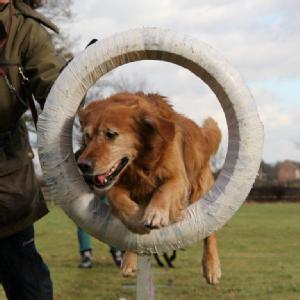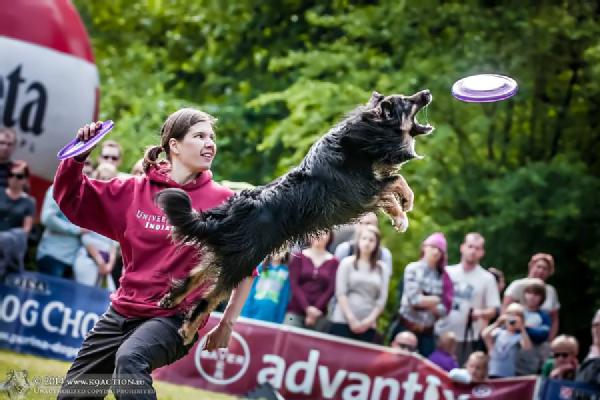Project Blog
Having Fun With Your Dog

Do More with Your Dog, the title of Kyra Sundance’s popular manual for teaching dogs tricks, has also become the motto for many humans who share their lives with companion dogs. And indeed, contemporary dog guardians are heeding this advice and engaging in scores of semi-formal activities that are viewed as contributing to the dog’s intellectual development and to mutual human-canine pleasure and enjoyment. We are encouraged to practice Tricks for a Better Bond (the title of one of Silvia Trkman’s popular videos) and to Gamify Your Training (the title of Terry Ryan’s 2016 manual). Agility handlers know very well that “Agility is Fun,” but it is not coincidental that this phrase was also the title of one of the first training manuals for this sport, published in 1989 and authored by Ruth Hobday. Fun has only gained importance in the decades since Hobday’s book first appeared. Supper Sniffer Scent Games, a manual for nosework training for the pet owner, is subtitled: A Guide to Having Fun with Your Dog. There’s even a book about Finding Your Fun in Competitive Obedience. The sport of obedience, which does have a marketing problem in the contemporary world, is trying to redefine itself as not really about enforcing obedience, but as a fun bonding activity for handler and dog.
Fun has become a unit of measuring the appeal of human-canine activities, which seems a far cry from the way dog training was perceived a hundred years ago, or even fifty years ago, when training might have been seen as necessary for ensuring more peaceful human-canine coexistence, but not as … play, not as fun. It was unpleasant drudgery that eventually brought about significant payoffs, but unpleasant drudgery, nonetheless. In Adam’s Task (1986), Vicki Hearne, a philosopher who wrote beautifully about the training of dogs and horses but who represented the more traditional approach to training, described training through play, that is training that is primarily pleasant for the dog, as harmless fun, but certainly not training: There is no harm in it, but it isn’t dog training” (90). Over three decades have passed since the publication of Hearne’s book, and one would now be hard pressed to find a serious dog training expert who concurs with Hearne’s dislike of training through play. This change of attitude is highly significant.
What to me seems the most striking about contemporary dog training is not the change in methods, that is in how we teach Rover to sit – though that is not insignificant – but in the functions dog training plays in the world of contemporary companion animal guardians. We – contemporary dog guardians or just “dog people” (for we do not like to call ourselves owners any more) – have begun to see the activity of dog training primarily as a way of building a positive relationship with our dogs, of opening up channels of communication, of learning more about the amazing species we share our lives with. We engage in dog training activities not only because we believe that having a well-trained dog will make our lives easier, but primarily because we see it as an activity that is tied to our dog’s well-being, as a way of alleviating canine boredom and providing the dog with wholesome intellectual and physical activity. The fact the we are even considering canine boredom as a factor that bears on the quality of life of our dogs is telling in itself: we have become attuned to issues of canine emotional well-being in ways that were unheard of a hundred years ago.
In the past three decades there has been an amazing outburst of activities one can engage in with one’s dog: agility, flyball, heelwork to music, canine nosework, canine disc (popular particularly in the US, though continental Europe and Japan are also major centers of this sport), rally obedience, dog-trekking (a booming activity in Central Europe), dummy trials, competitive trick-training (the American Kennel Club has recently launched a titling program in dog tricks). Treibball is an activity in which the dog is taught to circle and move large inflatable exercise balls. Not surprisingly, this modern sport is somewhat reminiscent of sheepherding (although real shepherds scorn it with a vengeance). Dock diving is a form of water play in which dogs are encouraged to jump off a dock into a special pool. Coincidentally, retrievers excel at this activity. The common thread among these activities is that they are not undertaken with the goal of bringing about financial profit for the animal’s owner in the way in which e.g. circus performances would or of sustaining the human’s livelihood like the training of sheepdogs or hunting dogs did. On the contrary, as anyone who has ever become involved in the world of dog training, training is a money pit for handlers. While for some more competitive trainers, trophies and the competitive aspects of these sporty activities may have some significance, the majority of recreational trainers firmly reply that they have the dog’s best interests in mind when choosing which activity to engage in.

Agility or frisbee are basically seen as safe outlets for the energy of active herding breeds, which were developed to work together with humans on accomplishing certain tasks. The tasks have changed, because the setting has changed. Agility or frisbee are better suited to an urban or suburban lifestyle, but we see them as replacements of more traditional human-canine activities. Dogs chase plastic discs instead of pursuing prey animals during hunting excursions. Nosework, or the skill of detecting and marking specific scents, is a civilian version of the rigorous training undertaken by dogs employed by the uniformed professions to locate drugs and other contraband. It so happens that it is also ideally suited for long winter evenings and/or for reactive dogs who do not adjust well to public settings, as it can be taught in the privacy of one’s own house. Agility and treibball are activities that can be played in a small field or indoor rink: locations that are more accessible for contemporary suburbanites than large open fields with flocks of sheep. Yet, we engage in these activities because we believe the original ones (hunting and herding) benefited not only the human, but also the dog, despite the sometimes-unsophisticated training methods which by contemporary standards many would consider cruel. We believe that a structured version of human-canine collaboration benefits both parties: the humans and the dogs; we believe that dogs have (been) developed in order to carry out work tasks for and in collaboration with humans and that engaging in a semblance of these work tasks gives the dogs some form of fulfillment, thus resulting in happy dogs (and, by extension, happy owners).
While the theses above are based to a large extent on personal observation – my own immersion in the world of dog training – there exists a growing number of academic studies that attempt to assess the motivation of participants in canine-human training activities, and the results of these studies are basically in line with these informal observations. For example, a 2015 study by Joey Farrell, conducted in Canada, reveals that most dog sports competitors there find pleasure in the relationship-building aspects of the activity. Committed dog guardians want to feel a strong bond with their dogs, and training becomes a way of building that bond and providing the dog with what we perceive as a replacement for more traditional ways of fulfilling their natural needs.
